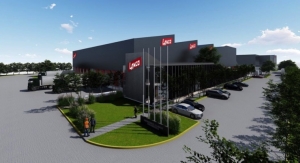08.06.21
According to a recent study from market research firm Graphical Research, the Europe anti-corrosion coatings market is poised to expand at substantial CAGR during the forecast period.
Without corrosion protection, the annual expenses of industrial corrosion damages that ultimately lead to machinery failure and production losses can be exorbitant. As pipelines, tubing, fasteners, and other industrial equipment is subject to adverse environmental conditions, water, sea salt, and chemicals, anti-corrosion coatings are an indispensable need.
The European anti-corrosion coatings market size exceeded USD $3,214 million in 2020 and is anticipated to exhibit a CAGR of 4.1% between 2021 and 2027. The growing energy sector, increasing need for new infrastructure, and rising installations of metal-based structures are set to fuel the market demand.
Tough offshore environments particularly require superior abrasion and corrosion resistance to boost the longevity of expensive equipment. The European anti-corrosion coatings market outlook is likely to gain from custom-made solutions for onshore and offshore equipment.
Following the closure of factories and industrial facilities due to the COVID-19 crisis, the metal and metal-based components have seen a reduction in demand during 2020. The imposition of lockdowns worldwide arrested manufacturing operations leading to declining production and consumption rates of metal. Although during 2020 Europe anti-corrosion coatings market share plunged by 9% in comparison with the previous year, 2021 is likely to see a recovery of economic activities, reviving market growth.
In terms of product type, Europe anti-corrosion coatings industry forecast has been differentiated into zinc, epoxy, acrylic, alkyd, polyurethane, chlorinated rubber, among others. Epoxy coatings emerged as a dominant segment, commanding over 42% of the industry share during 2020. By 2027, the upcoming expansion of industrial activities is likely to foster further growth.
Application of epoxy coatings to metal surfaces is a widespread practice across several industrial applications as they possess exceptional anti-chemical, anti-rust, and anti-abrasion properties. Apart from marine and construction industries, the oil & gas industry is expected to require epoxy coatings.
As several production units worldwide are resuming operations, Europe anti-corrosion coatings industry forecast is certain to ascend through 2027, pushed by the growing consumption of water-based coatings. Water-based coatings contain minimum levels of VOC. This renders the product a sustainable solution. Consumers have been turning to water-based coatings as European governments have been implementing strict regulatory policies regarding the use of hazardous compounds and chemicals.
The construction sector is also contributing toward overall market growth. Despite the economic volatility during the COVID-19 pandemic, investments from private and public sectors are accelerating the construction industry. By 2027, as the growing population has been demanding new residential projects, Europe anti-corrosion coatings market size is certain to proliferate.
Without corrosion protection, the annual expenses of industrial corrosion damages that ultimately lead to machinery failure and production losses can be exorbitant. As pipelines, tubing, fasteners, and other industrial equipment is subject to adverse environmental conditions, water, sea salt, and chemicals, anti-corrosion coatings are an indispensable need.
The European anti-corrosion coatings market size exceeded USD $3,214 million in 2020 and is anticipated to exhibit a CAGR of 4.1% between 2021 and 2027. The growing energy sector, increasing need for new infrastructure, and rising installations of metal-based structures are set to fuel the market demand.
Tough offshore environments particularly require superior abrasion and corrosion resistance to boost the longevity of expensive equipment. The European anti-corrosion coatings market outlook is likely to gain from custom-made solutions for onshore and offshore equipment.
Following the closure of factories and industrial facilities due to the COVID-19 crisis, the metal and metal-based components have seen a reduction in demand during 2020. The imposition of lockdowns worldwide arrested manufacturing operations leading to declining production and consumption rates of metal. Although during 2020 Europe anti-corrosion coatings market share plunged by 9% in comparison with the previous year, 2021 is likely to see a recovery of economic activities, reviving market growth.
In terms of product type, Europe anti-corrosion coatings industry forecast has been differentiated into zinc, epoxy, acrylic, alkyd, polyurethane, chlorinated rubber, among others. Epoxy coatings emerged as a dominant segment, commanding over 42% of the industry share during 2020. By 2027, the upcoming expansion of industrial activities is likely to foster further growth.
Application of epoxy coatings to metal surfaces is a widespread practice across several industrial applications as they possess exceptional anti-chemical, anti-rust, and anti-abrasion properties. Apart from marine and construction industries, the oil & gas industry is expected to require epoxy coatings.
As several production units worldwide are resuming operations, Europe anti-corrosion coatings industry forecast is certain to ascend through 2027, pushed by the growing consumption of water-based coatings. Water-based coatings contain minimum levels of VOC. This renders the product a sustainable solution. Consumers have been turning to water-based coatings as European governments have been implementing strict regulatory policies regarding the use of hazardous compounds and chemicals.
The construction sector is also contributing toward overall market growth. Despite the economic volatility during the COVID-19 pandemic, investments from private and public sectors are accelerating the construction industry. By 2027, as the growing population has been demanding new residential projects, Europe anti-corrosion coatings market size is certain to proliferate.



























